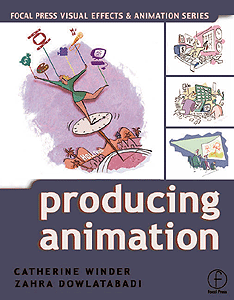Welcome to Producing Animation, Catherine Winder and Zahra Dowlatabadi's new book, which discusses the nuts and bolts and beyond, of the mysterious art of producing.
Editor's Note: Animation World Network is proud to host the Website for Catherine Winder and Zahra Dowlatabadi's long awaited, and much needed, book, Producing Animation. We feel this book will soon become one of the must have bibles of the animation industry. Over the course of the next year, Animation World Magazine will feature selected excerpts. The following is the introduction to the book and also to our special issue, which highlights producing animation.

What exactly does an animation producer do? What is a creative executive? How much does it cost to produce one minute of animation? How do you put a production plan together for animation? Are there significant differences between producing a feature, d-t-v (direct to video) and television series?
This is just a tiny sampling of the many questions that we are asked as soon as we reveal our profession as animation producers. We tried looking for books to recommend to people interested in the topic, but realized there wasn't a suitable title out there. Although there are many well-written and useful books that discuss the technical process and art of animation, there is nothing available that outlines the actual nuts and bolts of producing for major animation studios and distributors. Since this is a significant missing piece of the picture, we decided to use our combined knowledge and experience and take on the challenge. Producing animation is based on the ability to think logically, proactively and creatively. It is a cerebral act that combines a technical knowledge of the animation process with individual style, experience and gut instinct. Part of the problem of defining what an animation producer does is that the job function is truly amorphous. Throughout the animation industry, there is no single definition of what a producer does. And the role animation producers play on each project changes constantly. A producer's domain varies from production to production, as well as from studio to studio. The positive side of this variability is that producers are often able to shape the production to fit their own experience and expertise. On the flip side, it can lead to untested modes of production that can result in costly overages and frustrations for all involved.

In our opinion, the producer is the one person with the full overview and responsibility for a project from a creative, financial and scheduling perspective. Based on the creative expectations and fiscal parameters of the project, the producer pulls together an animation team. The producer sets up and manages both a production schedule and a budget, aiming to deliver the product at the agreed-upon level of quality. The producer is also in charge of keeping both the executives (or buyers) and the production team enthused and motivated. As this role is all encompassing, the knowledge base required to become a producer is quite extensive.

Our combined experience in the animation industry has been quite varied. Both of us progressed up through the ranks, and between the two of us, we have worked in almost all production capacities. Our job titles have included coordinator, production manager, overseas production manager, associate producer, line producer, co-producer, producer, executive producer, production executive and vice president, production. Zahra got her start in television production, but her career has been primarily focused on feature film and direct-to-video projects. Zahra's experience has been very hands on, working directly on the production lines. Catherine has worked in the areas of production and development for both television and feature films. Although she has rolled up her sleeves and produced several television series, the majority of her experience has been as an executive. She has overseen production facilities and projects in all formats, both domestically and internationally. She has also set up and run a studio from scratch. Combined, we have been involved in many different kinds of projects, including feature films, direct-to-video releases, television series, television specials and short films.

First Hand Experience
We first met each other on an ill-fated production in 1991. We were both hired as troubleshooters in the last 10 months of production for an animated feature film. In a short time, we discovered that there was actually closer to 20 months of work remaining to be done. With the story still in development, much of the production money was already spent. A completion bond company had moved into the production offices. The company was there to make sure that all production deadlines were met without failure so there would be no additional costs incurred. Their presence was a source of constant irritation for the producing team in Los Angeles.
The project was structured such that the pre-production and some of the production was completed in the L.A. studio. Due to the lack of available talent and budgetary and time restrictions, the work was then divided up and subcontracted to studios all over the world. Sections of the film were sent to Canada, Denmark, Spain, Australia and Argentina. Every scene ultimately ended up going through a studio in Asia for cleanup and ink and paint. Because each studio's availability and capabilities differed, the scenes had progressed to different stages of animation. Once scenes were finished in cleanup, they were sent to L.A. for key effects and then back to Asia. The Asians were the "catch-all" studio, completing any artwork that was not finished. Because the project was being outsourced to so many different studios, it was unclear where the approximately 1,350 scenes had been shipped, and how far along the production pipeline they had progressed. To top it off, the anemic tracking system in place proved to be completely out of date. It was our job to figure it all out and get the film completed by the fixed delivery date. Zahra was based in L.A. while Catherine was at a subcontracting studio in Asia. Once we got started, we quickly discovered that the project had been prematurely greenlit for production. (We should add that this is unfortunately a very common problem with animated projects.) None of the many changes taking place seemed to be able to fix its inherent story problems and only confused and complicated the production. At the home-base studio in L.A., the script was continuously changing. Character and location designs were being completely re-done. Scenes were being added and taken out as fast as they were being completed. The final deadline, however, remained firmly intact. It was impossible to feel like we were making any headway. As a result, the production crew was quickly losing their enthusiasm for the project. Given the number of studios working on the project, the cultural challenges were enormous. Receiving work from numerous animation studios, all communicating in different languages, made it extremely difficult for the American and Asian crews. Many of the artistic revisions had not made it all the way down the lines of communication to each studio around the world. Consequently, scenes that had already been fully animated had to be redrawn. Since it was often difficult to pinpoint exactly whose responsibility it was to make these changes, the burden rested on the Asian team to handle this additional work. Naturally, the L.A. studio had the highest expectations and made demands that were impossible to fulfill under the circumstances. Working six to seven days a week to try and catch up left the Asian crew feeling unappreciated and unable to put their best efforts forward. As time was short and they were being pressured, they had to make artistic compromises in order to get the scenes completed. Unfortunately, these creative shortcuts led to further frustrations by the L.A. team and resulted in even more revisions. The Asian crew was expected to produce top-rate animation, but there was no time for this in the schedule, so both teams often locked horns. Part of the problem was that the subcontractors were producing a feature film thousands of miles away from the creative decision-makers. The quality control checkpoints were impossible to implement without some artistic compromise. In short, we had our work cut out for us with the two main crews feeling frustrated, unhappy and burned out. An important consideration that should always be taken into account when running an international production is cultural traditions and holidays, both in the U.S. and abroad. With the clock ticking away, no one had planned for the Chinese New Year, which stopped production in the Asian studio for an entire week. At the same time, the L.A. crew had to contend with their own unexpected problem: the L.A. riots. It was not safe to be out on the streets, and the crew rightfully feared traveling to and from work. An angry driver had actually chased the head of the background department along the pavement of an L.A. street. In addition, all artwork shipments to and from the subcontracting studios were halted since the L.A. airport was very close to the hotbed of the riots.
As this was before the days of e-mail, we averaged 20 to 30 faxes a day to each other, trying to get a handle on the project. Fighting off packs of diseased dogs on the way to work helped Catherine limber up for the physical work ahead. As the entire studio took a daily nap, she would often have to climb up on the artists' desks to the shelves above in order to find missing scenes. (At some overseas studios, it is customary to sleep under the desk or on a cot since the crew literally works around the clock to get the work completed on time.) Meanwhile, back in L.A., the artistic supervisor wanted to keep tweaking key elements even after they were approved. As production in certain countries was on hold until they could get the materials, Zahra had to do evening reconnaissance missions to keep the show moving. Staying until everyone had left, she would search and find the artwork. The next day she would get the director's approval and coax the artistic supervisor into relinquishing the scenes in order to ship them out.

Somehow, through all the chaos, we managed to revise the schedule so that it was manageable. We put a tracking system in place and got scenes completed through production. Most importantly, we were able to motivate our team and finish the picture on time. It took a lot of emotional fortitude and diplomacy, as we were in the middle of a war zone with very high stakes and fiery tempers. At the end of it all, we both naively assumed that there had to be an easier way to produce a film. Over the years however, we have discovered that the complexity of the medium almost prohibits the possibility of a stress-free and orderly production. Many of the obstacles encountered are the direct result of the creative process itself and should be expected. However, many of the production snags are unnecessary and can be avoided with good planning and foresight.
Bridging Divides
Beyond committing to paper the nuts and bolts of producing animation, a primary purpose of this book is to help less experienced decision-makers (those new to the animation business, such as corporate executives and creators) to make smart, production-savvy decisions. Producing animation can be a highly rewarding experience. When developing a new project, there are no boundaries for creators, writers and artists, as the characters and their world can be created from scratch on a blank piece of paper. The rules of the physical world do not apply. As a result of this freedom, the possibilities are limitless. Achieving the appropriate balance between the creative goals and fiscal limitations of a project is the inherent challenge of every production. Despite having infinite potential paths to take, there inevitably comes a point in every production where choices have to be made and finalized. Having worked with many talented professionals, we have witnessed -- and also experienced -- the struggle to commit to creative decisions. Because this is so difficult, we have both wished we could refer these professionals to a source that explains the animation process and the implications of decisions made to the overall project.
On a project that I (Zahra) worked on as an associate producer, the development executive had an impressive live-action background, but no experience in animation. With the best of intentions to improve the film, this development executive took it upon himself to rewrite the dialogue for scenes, many of which had already been animated not just once, but multiple times. With the project rapidly falling behind schedule and going over budget, my job was to figure out which scenes could be safely worked on. Doing this would allow the project to meet production objectives and maintain momentum, as sufficient inventory would become available for each department. However, it was no easy task, as it seemed that no matter how I reworked the schedule and each department's weekly workload (also known as quotas), we were unable to move the project forward at a pace in keeping with the schedule. My top priority was to find a way to avoid the backward step of changing dialogue once a scene was animated. I had to devise a system that would allow us to catch scenes that required changes and stop them from entering production.
In order to get the work flowing through the animation department, I realized that I had to get on the same page as the executive. As an initial step, I invited him to attend dailies so he could get a sense of the process involved in animating a scene. (During dailies, scenes that have been completed through rough animation, cleanup animation, effect or color are viewed by the producer and director for approval.) While looking at the footage, the development executive was clearly impressed by the artistry that went into drawing each scene. My next step was to show the large stacks of drawings that made up the scenes we had just viewed. By his reaction, it was evident that the executive had not been aware of the staggering amount of work that went into getting the scenes animated.
I was very lucky because the executive was extremely smart and the brief introduction made him eager to learn more about animation. The first thing we had to establish was an understanding of the schedule. The timeline in animation can be deceptive for someone who is not familiar with the process. Even though we had close to two years of production time remaining, every day was already accounted for and there was little room for revisions. Together we explored the quota system -- that is, how a production relies on getting a certain number of feet or seconds completed through each department every week. Unless footage quotas are met in each category, there will not be enough work for the artists in the subsequent department to do. A domino effect ensues, causing the project to fall behind schedule. This offset travels all the way through the various departments to the end of the production line. While artists at the end of the production line have nothing to do, artists at the beginning of the production line are asked to undertake or work on the same scenes again and again. As revisions continue, these artists are caught in a vicious circle of not meeting their quotas. In the meantime, the time lag results in an escalation of department quotas in order to hit the film deadline, and the artists are pushed to produce more drawings every week. These circumstances create a self-defeating scenario in which the artists become demoralized, the production quality drops and the project falls behind schedule and runs over budget.
My attempt to bridge the gap between development and production gave the executive a better understanding of the consequences of his rewrites and the various challenges I was up against. It also gave me an opportunity to get to know him better and understand why he felt the changes were so critical to the project. Together, we figured out how to solve the problems we were facing. We established an "on-hold" category so that scenes he believed could potentially change were held back from production, thereby avoiding the waste of talent, time and money. He also requested to be copied on the production report in order to be more in sync with the project. Through our close collaboration, we were finally able to push the project forward and establish a mutually beneficial relationship between development and production.

Fundamental Strategies
Keeping in mind that each situation is unique, in this book we have attempted to define and clarify the process and procedures of producing animated projects with the focus on large-scale television, direct-to-video and feature production using 2D or traditional animation and 3D Computer Generated Imagery a.k.a. 3D CGI. The intended audience for Producing Animation is broad, ranging from film students to industry professionals. Our primary goal is to create a basis from which a producer can springboard and structure a production based on its individual needs. This book will take the reader through all the steps necessary to set up a project, including selling an idea, developing and preparing an idea for production, as well as the actual production process. For the entrepreneur producer who is trying to sell his or her project, this book will describe the role of and identify the industry professionals to contact. Producing Animation outlines the various stages a property goes through before production starts. For the student or line producer who may be strictly interested in the production phase, we offer detailed information on how to budget, schedule and track a project, as well as actual charts that can be used for such tasks. For professionals needing a basic knowledge of the animation business, this book provides answers to commonly asked questions, along with an overview of animation methodologies.
Unlike other forms of art, animation is a medium that is always changing. During the writing of this book, the industry has undergone phenomenal changes through technology and the Internet, making it almost impossible to keep up with all of its innovations. Many of the lessons we have learned, however, are fundamental to the business, no matter what the format or methodology. We hope that by sharing our own experiences we may help pave an easier path for future animation producers. Additionally, it is our sincere hope that the information in this book will entice new producers to enter the industry, and along with professionals already in the business, continue to push the frontiers of animation to more exciting and unforeseen territories.
Welcome to the wacky world of animation. We hope you enjoy its challenges, as there is nothing more satisfying than seeing the results of your hard work moving on the screen and the audience responding to it.
Catherine Winder has worked as both an executive producer in television and feature animation. Her background in development, as well as production with studios from around the world has given her a rare global expertise in the field of animation. In her present position as vice president production for Fox Feature Animation, she is overseeing production of the studio's 2D traditional and 3D CGI animated movies. She has co-written Producing Animation with Zahra Dowlatabadi.
Zahra Dowlatabadi, an award winning producer, started her animation career in 1986. Since then, Dowlatabadi has worked in almost every major studio in Los Angeles along with many internationally acclaimed animation studios and talent. Dowlatabadi is the founder of an organization entitled Animation Team, which assists studios with production staffing needs ranging from qualified line producers to experienced production assistants. She also has co-written a book entitled Producing Animation with Catherine Winder for Focal Press.







